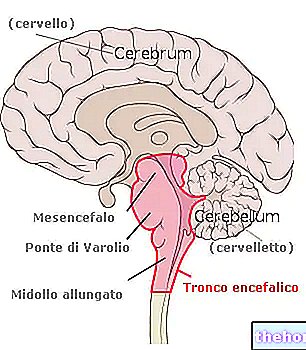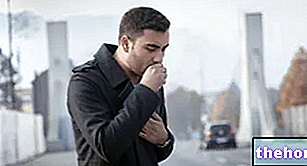Generality
The nose is made up of two distinct parts: an external, palpable and raised part called the nasal pyramid, and an internal one represented by the two nasal cavities (or cavities). The latter communicate with the outside through the nostrils and are separated sagittally by a thin osteo-cartilage plate, called the nasal septum.

The deviated nasal septum is, in many situations, asymptomatic (i.e. it does not cause any disturbance), but in some cases it can cause various manifestations, such as frequent nosebleeds, disturbed sleep, respiratory disorders, etc.
Diagnosis is usually based on a careful physical examination.
If the complaints are unbearable, it is necessary to resort to septoplasty, or surgery to straighten the deviated nasal septum.
What is the deviated septum?
The deviated nasal septum is a disorder that occurs when the osteo-cartilage plate interposed between the two nasal cavities undergoes a deviation to the right or to the left.
This deviation, in many people, narrows the canal of the affected nostril, reducing the flow of air through it. If this reduction is so severe as to constitute a real impediment to the passage of air, it is called nasal obstruction (or nasal congestion) of a pathological type.
Deformities caused by deviation of the nasal septum are permanent.
WHAT IS THE PATHOLOGICAL NASAL OBSTRUCTION (OR NASAL CONGESTION)
Pathological nasal obstruction, more commonly known as pathological nasal congestion or stuffy nose, is a very common respiratory tract disorder, which can arise for one or more of the following reasons:
- Accumulation of mucus inside the nasal cavities (due, for example, to a cold, an allergy, a form of sinusitis, rhinorrhea, etc.)
- Inflammation of the lining (mucous) tissues of the nasal passages
- Deviated nasal septum
- Gastric reflux
- Nasal polyposis
- Enlargement of the adenoids
Causes
The nasal septum can be deviated from birth, or it can deviate in the course of life, due to a traumatic event affecting the nose.
Furthermore, as we will see later, aging also plays a decisive role.
NASAL SEPTUM DEVIATED AT BIRTH
The deviation of the nasal septum, present from birth, can be the effect of an event that occurs during fetal development (a completely imponderable eventuality), or the consequence of a problematic birth.
In these situations, in general, the deviation is not so evident and problematic; however, it can become so over the course of life, due to aging or one or more repetitive trauma.
Special case. Some individuals, who are born with serious genetic diseases such as Marfan syndrome, homocystinuria or Ehlers-Danlos syndrome, may present, among other pathological characteristics, a deviated nasal septum.
NASAL SEPTUM DEVIATED BY TRAUMA TO THE NOSE
In most cases, the deviated nasal septum arises as a result of traumatic episodes, which occur during childhood, adolescence and adult life.
When you are a child or a teenager, the most common causes are involuntary falls or collisions with other peers during a game.
When you are an adult, on the other hand, the most common reasons are sports injuries (especially in contact sports, such as football, rugby, boxing, etc.), domestic ones and road accidents (especially those in which you do not wear a seat belt) .
NASAL SEPTUM DEVIATED AND AGING
Most common risk factors:
- Contact sports (football, rugby, boxing, etc.)
- Road accidents, especially those in which the driver does not use a seat belt
Less common risk factors:
- Particular congenital diseases (Marfan syndrome, homocystenuria, syndrome of)
The normal aging process influences the anatomy of the nasal cavities, worsening, in some cases, the deviation of the nasal septum and making it problematic. This process results in the need, in adulthood, to resort to surgery, despite never having significant traumatic events occurred.
Symptoms and Complications
In many cases, deviated septal deformities do not cause any symptoms, so much so that patients do not even know they have them.
In other people, however, they can cause various ailments, some even very annoying:
- Obstruction of one or both nostrils. The deviation of the nasal septum can be so pronounced that the patient breathes with difficulty. This possibility can affect one or both nostrils. Often, the problem is accentuated by the onset of a cold or an allergy, as they further restrict the passage for air.
- Frequent nose bleeds (epistaxis). Due to septal deformities, the lining tissues of the nasal passages (the mucosa) dry out, increasing the risk of nosebleeds, or nosebleeds.
- Facial pain. It seems (but the veracity of this hypothesis is still debated) that the deviated nasal septum causes pain in the face, on the same side where the nostril is partially occluded.
- Breathing disturbances in sleep. Infants and children in particular suffer from it. Often, they are the result of the simultaneous presence of a deformity of the nasal septum and an "inflammation of the tissues that line the nasal cavities.
- Awareness of the nasal cycle. The nasal cycle is a physiological process of humans and other animals, during which the nasal cavities undergo alternating congestion and decongestion. In other words, the nostrils are never open at the same time, but once the right one is, another time the left one is. The peculiarity of this process is the fact that it is completely imperceptible. When you suffer from nasal septum deviated, however, it is possible to realize how the nasal cycle works.
- Preferably sleep on one side of the body. Some patients find that they sleep better on either side of the body, as this position allows them to breathe better.
COMPLICATIONS
A very deviated nasal septum can be the cause of that situation that has been defined above pathological nasal congestion.
The latter, when it arises, involves one or more of the following complications: dry mouth, a sense of pressure in one of the nasal passages and disturbed sleep.
The so-called dry mouth (or xerostomia), is caused by the fact that the patient, unable to breathe effectively through the nose, constantly breathes through the mouth.
Similarly, disturbed sleep also depends on bad breathing: the patient cannot find a position, in the bed, that is conciliatory with sleep.
WHEN TO SEE THE DOCTOR?
It is advisable to contact your doctor, for a consultation, when you develop continuous infections of the nasal sinuses, when you are subject to repeated episodes of nosebleeds or, finally, when the stuffy nose does not improve with the various decongestant sprays and medicines.
This "last case deserves" particular attention: the deviated nasal septum is, as we have said, a permanent condition, therefore the nasal congestion, which could derive from it, is equally so; on the contrary, a "nasal obstruction caused by a" mucosal inflammation is a temporary situation, which can be treated with decongestant sprays and appropriate medications.
Diagnosis
The most common procedure for diagnosing deviated septum is to subject the patient to a thorough physical examination and ask him to describe all the symptoms felt.
During the check-up, the doctor uses a very bright light and a special instrument, called a nasal speculum, capable of opening the nostrils well. It is very common for the nasal cavities to be observed both before and after a decongestant treatment, so that we can understand what the internal tissues of the nose look like.
In some special cases, a more invasive diagnostic test is required than the simple physical examination: nasal endoscopy.
Deepening: what is nasal endoscopy?
Nasal endoscopy is a minimally invasive diagnostic procedure, through which the structures and internal lining of the nasal cavities are observed in detail. It involves the use of an endoscope, that is a thin rigid tube fitted, at one end, with a light source and a camera: this device, once the light and the camera have been put into operation, projects the images of what it "sees" on a monitor.
Nasal endoscopy is not particularly painful, however it can be uncomfortable, especially if the patient suffers from a deviated nasal septum or severe inflammation of the internal mucosa.
It lasts about 20 minutes and requires, before execution, a decongestant treatment and the use of a local anesthetic.
Treatment
The only way to correct the deviated nasal septum, when it creates unbearable disturbances, is through a surgical procedure, known as septoplasty.
While waiting for the operation, the patient very often undergoes some pharmacological treatments, such as nasal decongestants, antihistamines, etc., which alleviate the symptoms and allow relief, at least temporary.
PHARMACOLOGICAL TREATMENT WAITING FOR THE INTERVENTION
The drugs, listed below, do not cure the deviated nasal septum, but are, however, a good temporary solution.
It is possible to use:
- Decongestants. In the form of pills or sprays, these medicines reduce the thickness of the inner lining of the nose. This ensures a wider opening of the nostrils and a better passage of air through them.
Side effects: Frequent use can be addictive and / or worsen the intensity of symptoms once their use is stopped. In addition, they cause anxiety, hypertension and tachycardia. For all these reasons, it is best to take such medicines with extreme caution.
- Antihistamines. They are generally taken to prevent allergies and some associated ailments, such as itchy nose and nasal obstruction, but they can also have beneficial effects in case of colds and other not strictly allergic manifestations.
Side effects: they can make you drowsy, therefore, before driving a vehicle or performing other similar activities, it is best not to use them.
- Cortisone spray. Cortisone, which is the active ingredient in these drugs, is a powerful anti-inflammatory. Cortisone sprays are particularly suitable when the patient suffers not only from a deviated nasal septum, but also from an "inflammation of the internal tissues of the nose.
Side effects: cortisone-based medicines cause many side effects, from osteoporosis to diabetes, from hypertension to weight gain. Therefore, it is normally recommended to take them for a limited period of time, ranging from a minimum of one to a maximum of three weeks.
SURGICAL INTERVENTION: SEPTOPLASTICS
During septoplasty, the surgeon straightens and repositions the deviated septum in the center of the nasal passages.

The procedure can be performed under general anesthesia or local anesthesia, based on the patient's characteristics (age, allergies to anesthetic drugs, etc.) and the intentions of the operating surgeon.
Septoplasty guarantees excellent results, even if, obviously, the best benefits are obtained by those with a nasal septum that is only slightly deviated.
Important note: septoplasty does not solve the problem of allergic manifestations, such as stuffy nose and itchy nose. These, in fact, occur independently of the deviated nasal septum; therefore, those who are usually subject to it will continue to be so even after septoplasty.
Prognosis
Those who want to heal from the disorders caused by the deviated nasal septum can only resort to septoplasty. This surgery is safe, effective and is outpatient, therefore the prognosis is positive.
On the other hand, those who, despite presenting a deviation of the nasal septum, do not show any symptoms, can also do without undergoing the operation.
PREVENTION
Wearing appropriate protection during contact sports, putting on a seat belt in the car, proceeding with caution when doing housework, etc., are the most recommended precautionary measures to prevent a deviated septum or its worsening.




.jpg)























